Answered step by step
Verified Expert Solution
Question
1 Approved Answer
School principals' perceptions of team management A significant development in the South African education system over the past decade has been the move towards site-based
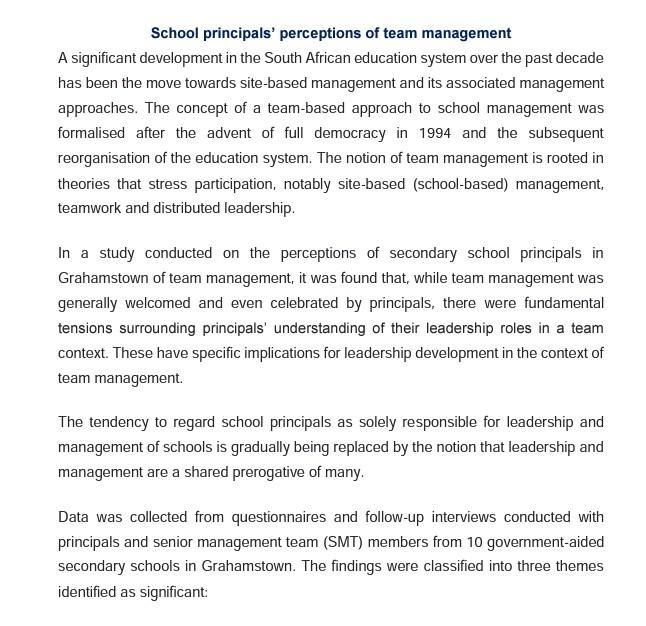
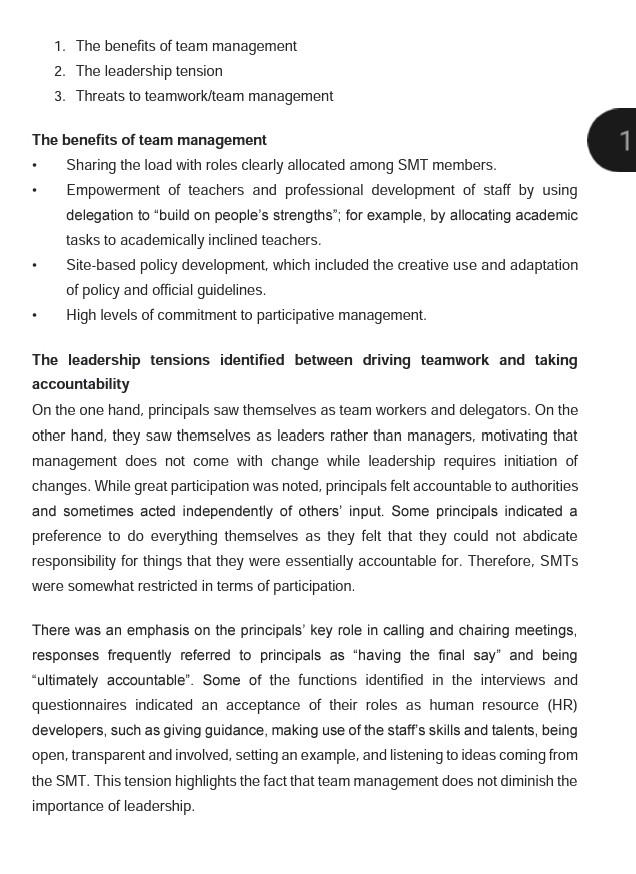
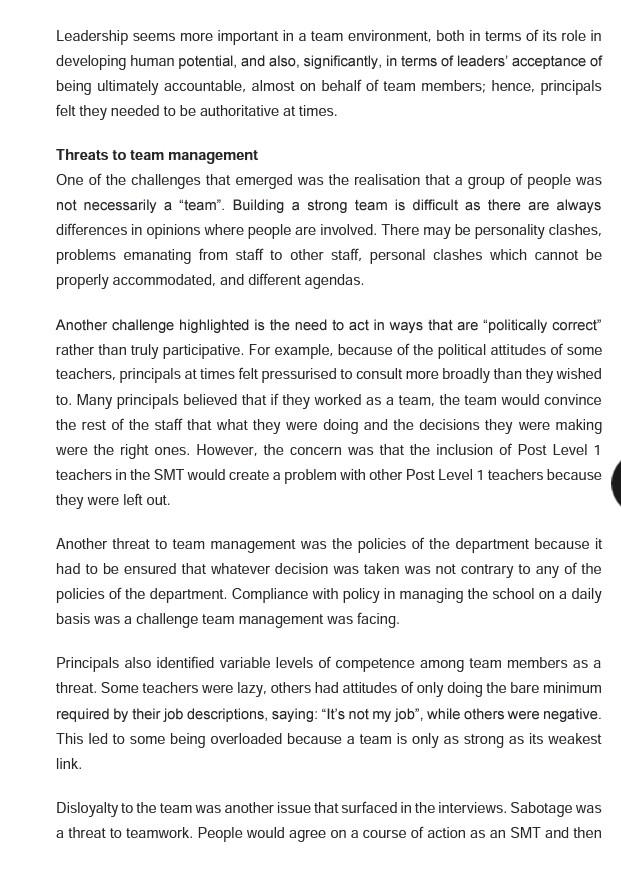
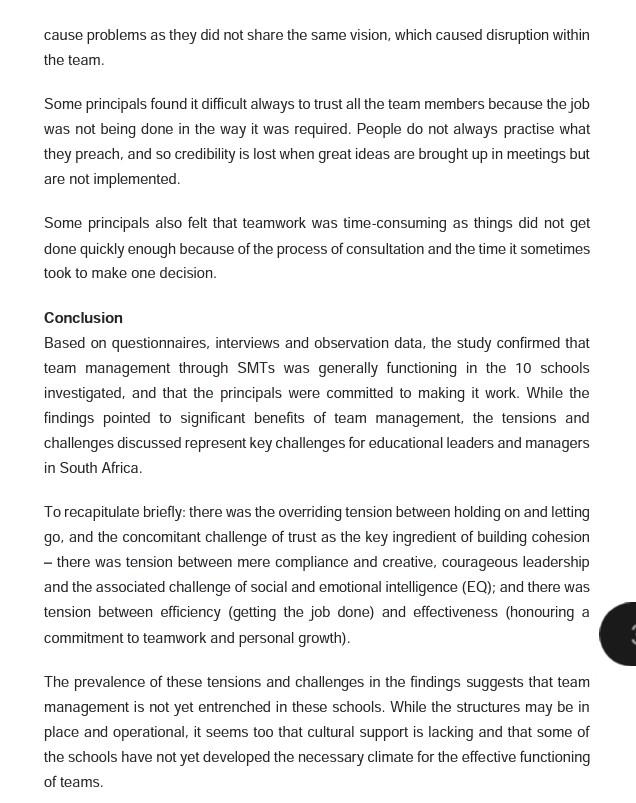
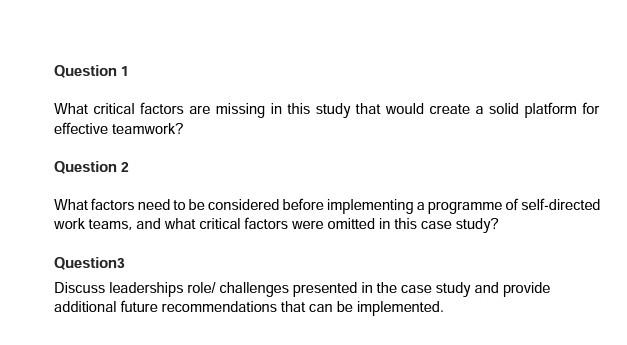
School principals' perceptions of team management A significant development in the South African education system over the past decade has been the move towards site-based management and its associated management approaches. The concept of a team-based approach to school management was formalised after the advent of full democracy in 1994 and the subsequent reorganisation of the education system. The notion of team management is rooted in theories that stress participation, notably site-based (school-based) management, teamwork and distributed leadership. In a study conducted on the perceptions of secondary school principals in Grahamstown of team management, it was found that, while team management was generally welcomed and even celebrated by principals, there were fundamental tensions surrounding principals' understanding of their leadership roles in a team context. These have specific implications for leadership development in the context of team management. The tendency to regard school principals as solely responsible for leadership and management of schools is gradually being replaced by the notion that leadership and management are a shared prerogative of many. Data was collected from questionnaires and follow-up interviews conducted with principals and senior management team (SMT) members from 10 government-aided secondary schools in Grahamstown. The findings were classified into three themes identified as significant: 2. The leadership tension 3. Threats to teamwork/team management The benefits of team management - Sharing the load with roles clearly allocated among SMT members. - Empowerment of teachers and professional development of staff by using delegation to "build on people's strengths"; for example, by allocating academic tasks to academically inclined teachers. - Site-based policy development, which included the creative use and adaptation of policy and official guidelines. - High levels of commitment to participative management. The leadership tensions identified between driving teamwork and taking accountability On the one hand, principals saw themselves as team workers and delegators. On the other hand, they saw themselves as leaders rather than managers, motivating that management does not come with change while leadership requires initiation of changes. While great participation was noted, principals felt accountable to authorities and sometimes acted independently of others' input. Some principals indicated a preference to do everything themselves as they felt that they could not abdicate responsibility for things that they were essentially accountable for. Therefore, SMTs were somewhat restricted in terms of participation. There was an emphasis on the principals' key role in calling and chairing meetings, responses frequently referred to principals as "having the final say" and being "ultimately accountable". Some of the functions identified in the interviews and questionnaires indicated an acceptance of their roles as human resource (HR) developers, such as giving guidance, making use of the staff's skills and talents, being open, transparent and involved, setting an example, and listening to ideas coming from the SMT. This tension highlights the fact that team management does not diminish the importance of leadership. Leadership seems more important in a team environment, both in terms of its role in developing human potential, and also, significantly, in terms of leaders' acceptance of being ultimately accountable, almost on behalf of team members; hence, principals felt they needed to be authoritative at times. Threats to team management One of the challenges that emerged was the realisation that a group of people was not necessarily a "team". Building a strong team is difficult as there are always differences in opinions where people are involved. There may be personality clashes, problems emanating from staff to other staff, personal clashes which cannot be properly accommodated, and different agendas. Another challenge highlighted is the need to act in ways that are "politically correct" rather than truly participative. For example, because of the political attitudes of some teachers, principals at times felt pressurised to consult more broadly than they wished to. Many principals believed that if they worked as a team, the team would convince the rest of the staff that what they were doing and the decisions they were making were the right ones. However, the concern was that the inclusion of Post Level 1 teachers in the SMT would create a problem with other Post Level 1 teachers because they were left out. Another threat to team management was the policies of the department because it had to be ensured that whatever decision was taken was not contrary to any of the policies of the department. Compliance with policy in managing the school on a daily basis was a challenge team management was facing. Principals also identified variable levels of competence among team members as a threat. Some teachers were lazy, others had attitudes of only doing the bare minimum required by their job descriptions, saying: "It's not my job", while others were negative. This led to some being overloaded because a team is only as strong as its weakest link. Disloyalty to the team was another issue that surfaced in the interviews. Sabotage was a threat to teamwork. People would agree on a course of action as an SMT and then cause problems as they did not share the same vision, which caused disruption within the team. Some principals found it difficult always to trust all the team members because the job was not being done in the way it was required. People do not always practise what they preach, and so credibility is lost when great ideas are brought up in meetings but are not implemented. Some principals also felt that teamwork was time-consuming as things did not get done quickly enough because of the process of consultation and the time it sometimes took to make one decision. Conclusion Based on questionnaires, interviews and observation data, the study confirmed that team management through SMTs was generally functioning in the 10 schools investigated, and that the principals were committed to making it work. While the findings pointed to significant benefits of team management, the tensions and challenges discussed represent key challenges for educational leaders and managers in South Africa. To recapitulate briefly: there was the overriding tension between holding on and letting go, and the concomitant challenge of trust as the key ingredient of building cohesion - there was tension between mere compliance and creative, courageous leadership and the associated challenge of social and emotional intelligence (EQ); and there was tension between efficiency (getting the job done) and effectiveness (honouring a commitment to teamwork and personal growth). The prevalence of these tensions and challenges in the findings suggests that team management is not yet entrenched in these schools. While the structures may be in place and operational, it seems too that cultural support is lacking and that some of the schools have not yet developed the necessary climate for the effective functioning of teams. Question 1 What critical factors are missing in this study that would create a solid platform for effective teamwork? Question 2 What factors need to be considered before implementing a programme of self-directed work teams, and what critical factors were omitted in this case study? Question3 Discuss leaderships role/ challenges presented in the case study and provide additional future recommendations that can be implemented
Step by Step Solution
There are 3 Steps involved in it
Step: 1

Get Instant Access to Expert-Tailored Solutions
See step-by-step solutions with expert insights and AI powered tools for academic success
Step: 2

Step: 3

Ace Your Homework with AI
Get the answers you need in no time with our AI-driven, step-by-step assistance
Get Started


